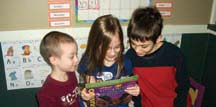Home made education
Why more families are home schooling
By Tracey Ellis
Kira LaFrance home schools her four children, Etienne, 9; Marieve, 7; Joseph, 4, and Thérèse, 2.
According to Kira the choice to home school your children is a deeply personal one that involves strengthening family ties as you explore the world around you through the joy of learning.
 "It's one of those things that develops when you are pregnant," Kira relates. "I read a book on the topic and thought to myself, what a beautiful idea, to be able to stay home with my kids."
"It's one of those things that develops when you are pregnant," Kira relates. "I read a book on the topic and thought to myself, what a beautiful idea, to be able to stay home with my kids."
The Fraser Institute reports home schooling is on the rise with a steady progression from what was once considered an extreme form of education to a mainstream alternative. In 1979, 2,000 children in Canada were being home schooled but by 1996 this number had risen to 17,523. In the United States similar trends were noted with numbers jumping from 50,000 home schooled students in 1985 to an estimated 850,000 in 1999 and an estimated 1.9 million in 2010 according to the US Department of Education.
In Powell River, Don Fairbairn, Director of Instruction with the Partners in Education program for School District 47, reports current enrollment has grown from 23 in 2003 to the current number of 160.
According to Fairbairn, the Partners in Education program was started in 2003 to meet the needs of a small group of Powell River students, whose parents had elected for a variety of reasons, to involve their children in a number of divergent home school programs throughout the province.
"The parent group felt that a Powell River-based distributed learning program might be able to meet student needs more effectively than some of the Distance Education programs in which they had been enrolled," Fairbairn said. "At this point, we do not actively recruit students, but are still growing slowly via word of mouth." Three teachers in Powell River and four on Vancouver Island provide parents with the support they need.
When it came time to enroll her son in school Kira asked her husband, who is a teacher, for an outline of the curriculum. "I quickly realized that I could do this!" Kira and her children have never looked back and Kira hopes to be able to home school her children through to Grade 12.
"Some students come to home schooling and stay right through to graduation," Fairbairn said. "Others stay until 9 or 10 and then return to regular school. About two-thirds of our students I would expect to stick with home schooling until grad. We also tend to pick up quite a number of part-time students at the secondary level who take a partial load with us--one or two courses, but take the rest in a regular school."
Class begins at the LaFrance household at 9 am weekdays and ends at noon, although some assignments can take until 2 pm to complete as the children work at their own pace. How does she keep her children focused? She keeps the television turned off during the week. "It's too distracting." Kira concentrates on keeping things fun and works the curriculum around current interests. Her oldest son's interest in reading about Greek mythology translates easily into a creative writing assignment on creating his own hero written in the style of The Iliad. Her daughter's interest in big cats becomes a research project into Siberian Tigers for another assignment. "When we read about flowers, we might go outside and look at some flowers," she says. "We keep things fascinating by doing and talking and research."
By choosing to educate her children at home, Kira has given her children a precious gift--they are learning to love to learn.
Why homeschool?
Some benefits of home schooling in the eyes of the parents, according to the Fraser Institute report, are:
• Opportunity to instill a particular set of morals and values in their child.
• A higher academic achievement level and one-on-one instruction.
• Stronger parent-child relationships.
• High quality interaction with peer groups and adults.
• Escape from the negative effects of peer pressure.
• A physically safer environment.